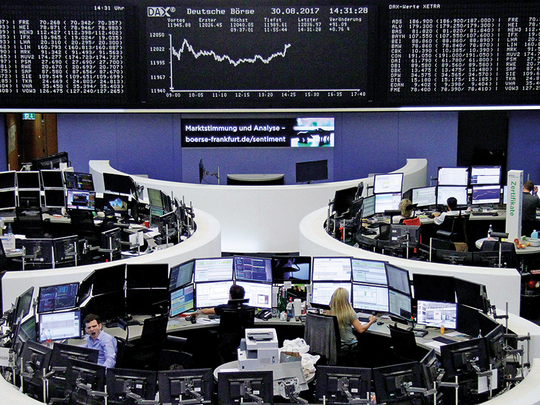
LONDON: Investors rediscovered a taste for the dollar and commodities on Thursday, as upbeat Chinese and US economic news whetted appetite for riskier assets globally, while tensions over North Korea simmered in the background.
One big gainer was US gasoline which surged 6 per cent to two-year peaks as flooding and damage from Tropical Storm Harvey shut nearly a quarter of US refinery capacity. Prices are up more than 20 per cent in the past week.
Adding to the bullish mood, a survey showed Chinese factory growth unexpectedly accelerated in August, confounding forecasts for a slight slowdown. The official PMI firmed to 51.7, from 51.4 in July.
That gave a boost to industrial metals, with copper nearing its highest since late 2014 and on track for gains of 7 per cent for August.
European shares firmed too, with London’s FTSE, Germany’s DAX and France’s CAC40 ahead by 0.6 — 0.8 per cent. Eurozone inflation marginally beat forecasts, which should give the European Central Bank heart when it meets next week.
Wall Street futures pointed to 0.3 per cent gains for the main S&P 500, Dow and Nasdaq markets.
Traders there will also be digesting inflation data as a debate continues about whether the Federal Reserve will raise US
interest rates again this year.
“It is almost like we have ended up with a default risk-on (scenario), which is in part predicated on the very benign pricing for what central banks do next,” said head of global macro strategy at State Street Global Markets, Michael Metcalfe.
“And that is why the inflation numbers now will be important,” especially with energy prices and commodity prices having risen over the last couple of months. “The period where we could have expected favourable inflation numbers (for keeping interest rates low) may have passed.” In Asia, Japan’s Nikkei had closed up 0.7 per cent, its best level in two weeks, helped by a pullback in the yen.
MSCI’s broadest index of Asia-Pacific shares outside Japan edged down on the day as emerging market stocks more broadly took a breather too.
But August has been their eighth straight month of gains — their best run since 2003 and driving an almost 30 per cent surge in EM equities this year.
The yuan posted its biggest monthly gain, in percentage terms, since the Chinese currency was revalued and taken off a fixed dollar peg in 2005.
The onshore yuan has risen just over 2 per cent against the dollar in August, a sizeable gain for a currency that typically trades in a wafer-thin range.
Seeking an answer
Wall Street had got a boost on Wednesday when data showed the US economy grew at an upwardly revised 3 per cent annualised pace in the second quarter, courtesy of robust consumer spending and strong business investment.
Other figures showed US private-sector employers hired 237,000 workers in August, the biggest monthly increase in five months and an upbeat signal for payrolls on Friday.
The better economic news helped distract from rumblings in the Korean peninsula and lifted the dollar.
President Donald Trump on Wednesday declared “talking is not the answer” to the tense standoff with North Korea over its nuclear missile development, but his defence chief said diplomatic solutions were still an option.
Against a basket of major currencies, the dollar crept ahead to 93.196, up from a 2-1/2-year low of 91.621 touched on Tuesday and on course for its first monthly rise since February.
The dollar also bounced to 110.50 yen, off a 4-1/2-month low of 108.25.
The euro retreated to $1.1845 from its top of $1.2069, weighed in part by speculation the European Central Bank might start to protest at the currency’s strength.
“The exchange rate has become a bigger issue,” an ECB source told Reuters on Thursday. “It is now less favourable for an exit (from the bank’s 60 billion-euro-a-month stimulus programme) and a stronger argument for a muddle-through option.” The euro has risen over 13 per cent against the dollar this year as pessimism over the euro bloc has dissipated and its economy has started to gain some traction.
Eurozone bond yields — which move inversely to price — have moved back down though in line with US Treasuries, which are back at 2.14 per cent after their biggest monthly drop in over a year.
The bounce in the dollar shaved 0.5 per cent off the price of gold to $1,302.50 an ounce, short of Tuesday’s 9-1/2-month high of $1,325.94.
With so much US refinery capacity shut in the wake of Tropical Storm Harvey, oil prices were hit by demand concerns.
Brent eased 9 cents to $50.77 a barrel, while US crude hovered at $46.05.












